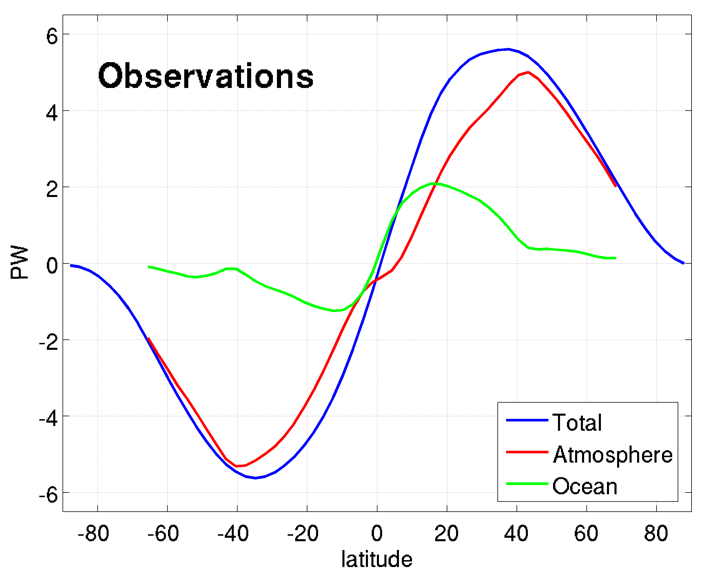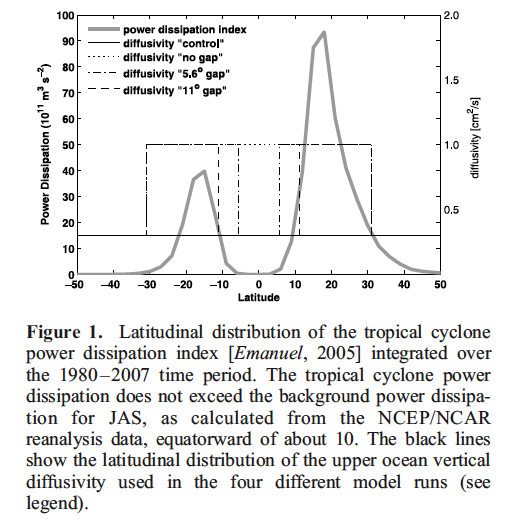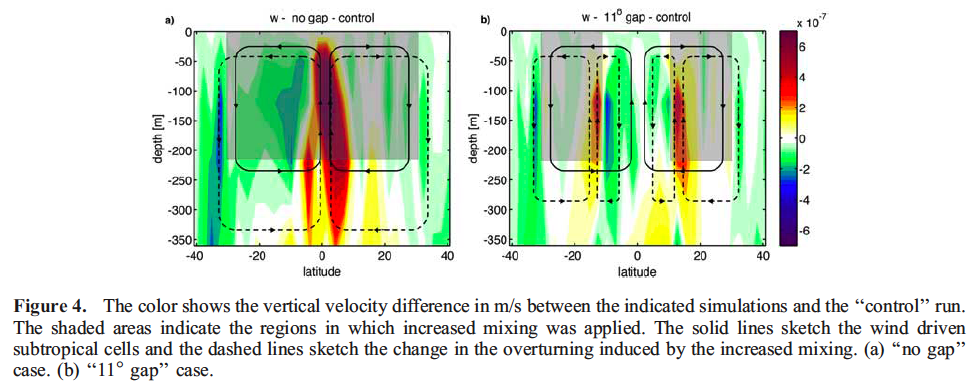Following Emanuel's hypothesis about tropical cyclones, other people have investigated the impact of cyclones on OHT and the possibility of cyclones causing equable climates. The other studies have shown that tropical cyclones do increase OHT; however, there are some aspects of the system that Emanuel did not consider in his first paper.
Ryan L. Sriver and Matthew Huber examined SSTs before and after tropical cyclone events to see the effects of cyclones on OHT. They used the difference in temperatures to estimate the amount of vertical mixing that occurred as a result of cyclones, and they assumed that any cooling that occurred on the sea surface was a result of vertical mixing. After they had obtained estimates for the amount of vertical mixing, they assumed that all of the heat diffused downward eventually had to have been translated into OHT. Their results showed that roughly 15% of peak OHT is attributable to mixing induced by tropical cyclones and that about half of the thermohaline circulation may result from this same vertical mixing (Sriver and Huber, 2007). Additionally, they found that tropical SSTs are highly correlated to globally integrated annual ocean heat content (OHC) and OHT (r2=0.73). When tropical SSTs decrease, OHC and OHT increase. As a result, their data supports the idea that cyclone activity increases OHT out of the Tropics, but they fail to acknowledge one important aspect of OHT.

Sriver's and Huber's study shows a correlation between cyclone activity, SST, and OHT. (Sriver and Huber, 2007)
The ocean is very good at removing heat from the Tropics and moving it to the mid-latitudes; however, by about 50° latitude, the ocean does not transport much heat further north. Instead, the atmosphere handles most of the heat transport after that point. This fact hurts Emanuel's hypothesis because the ocean does not to bring heat to the high-latitudes, so even if tropical cyclones were to increase in frequency or intensity, the heat would only be transported to the mid-latitudes. Therefore, it seems unlikely that tropical cyclones would be fully responsible for equable climates.

Ocean OHT (green) drops off by about 50°. (MIT's CMI)
Work by Malte Jansen and Raffaele Ferrari also has exposed a problem with Emanuel's idea. In their paper from 2009, Jansen and Ferrari examine the effects on OHT based on where mixing occurs. They argue that cyclones do not mix the entire area around the equator but rather that they generally mix certain latitude bands. They base this idea off of the fact that tropical cyclones rarely tend to happen equatorward of 8° to 10° latitude (Jansen Ferrari, 2009). This trend exists because water slightly north and south of the equator actually tends to be warmer than water at the equator because upwelling of cold, deep water at the equator cools the sea surface there.

Cyclones tend to occur in bands off of the equator. (Jansen and Ferrari, 2009)
Using this fact as a basis, Jansen and Ferrari performed a study to examine the effects of mixing when it occurs in different latitude bands. In the study, they performed four different runs: a control run that simulated normal conditions, a "no gap" run that had mixing between 31°N and 31°S, a run with mixing between 5.6° and 31° latitude, and a run with mixing between 11.2° and 31° latitude. The "no gap" run revealed that when mixing occurs throughout all of the low-latitudes poleward OHT increases. The runs with gaps, however, showed a different result. When mixing did not occur in a gap around the equator, both poleward and equatorward OHT existed. The model demonstrated that two different circulation cells could form with water moving away from the mixing band and sinking in the poles and at the equator. Because some of the heat would move toward the equator, having a gap would reduce poleward OHT. In their own words, "mixing triggered by [tropical cyclones] primarily induces an equatorward transport of heat and results in an overall decrease of poleward OHT out of the equatorial region" (Jansen and Ferrari, 2009). Therefore, their study contradicts Emanuel's thoughts. While it is possible that tropical cyclones could increase poleward OHT, they are more likely to reduce poleward OHT and to increase equatorward OHT because they rarely occur directly over the equator. Using the characteristics of tropical cyclones' locations as their base, Jansen and Ferrari show that it is unlikely that tropical cyclones instigated equable climates.

The "no gap" run increases poleward OHT, while the gap runs show both poleward and equatorward OHT. (Jansen and Ferrari, 2009)
